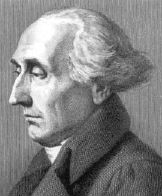

Joseph-Louis Lagrange is usually considered to be a French mathematician, but he was born in Italy. He studied at the College of Turin, and his favorite subject was classical Latin. At first he had no great enthusiasm for mathematics, finding Greek geometry rather dull.
Lagrange's interest in mathematics began when he read a copy of Halley's 1693 work on the use of algebra in optics.
Lagrange was largely self-taught and did not have the benefit of studying with leading mathematicians. In 1754, he published his first mathematical work, an analogy between the binomial theorem and the successive derivatives of the product of functions.
He began working on the tautochrone, and made some important discoveries which would contribute substantially to the new subject of the calculus of variations. After sending some results to Euler and impressing him, he was appointed professor of mathematics at the Royal Artillery School in Turin in 1755. In 1756, Lagrange generalized results which Euler
had himself obtained in calculus of variations.
In 1756, he was elected to the Berlin Academy. In 1757, Lagrange was a founding member of what would become the Royal Academy of Science of Turin. One of the major roles of this new Society was to publish a scientific journal. Lagrange was a major contributor to the first three volumes.
The papers by Lagrange which appear in these transactions cover a variety of topics. He published his beautiful results on the calculus of variations, and a
short work on the calculus of probabilities. In a work on the foundations of dynamics, Lagrange based his development on the principle of least action and on kinetic energy.
He also made a major study on the propagation of sound, making important contributions to the theory of vibrating strings. Lagrange used a discrete mass model for his vibrating string, which he took to consist of n masses joined by weightless strings. He solved the resulting system of n+1 differential equations, then let n get large to obtain a functional solution.
In papers which were published in the third volume, Lagrange studied the integration of differential equations and made various applications to topics such as
fluid mechanics, where he introduced the Lagrangian function. Also contained are methods to solve systems of linear differential equations which used the
characteristic value of a linear substitution for the first time. Another problem to which he applied his methods was the study the orbits of Jupiter and Saturn.
In 1766, Lagrange accepted Euler's position in the Berlin Academy when Euler left for St. Petersburg. He was greeted warmly by most members of the Academy, and he soon became close friends with Lambert. For 20 years, Lagrange worked at Berlin, producing a steady stream of top quality papers and regularly winning the prize from the Académie des Sciences of Paris. He shared the 1772 prize on the three body problem with Euler, won the prize for 1774, another one on the motion of the moon, and he won the 1780 prize on perturbations of the orbits of comets by the planets.
His work in Berlin covered many topics: astronomy, the stability of the solar system, mechanics, dynamics, fluid mechanics, probability, and the foundations
of the calculus. He also worked on number theory, proving in 1770 that every positive integer is the sum of four squares. In 1771, he proved Wilson's theorem, that n is prime if and only if (n-1)! + 1 is divisible by n. In 1770, he also presented an important work
which made a fundamental investigation of why equations of degrees up to 4 could be solved by
radicals. The paper is the first to consider the roots of a equation as abstract quantities rather than having numerical values. He studied permutations of the
roots and, although he does not compose permutations in the paper, it can be considered as a first step in the development of group theory continued by Ruffini, Galois and Cauchy.
In 1787, after the death of his wife and Frederick II, Lagrange's position in Berlin became
a less happy one. He left Berlin to become a member of the Académie des Sciences in Paris, where he remained for the rest of his career. Lagrange
survived the French Revolution while others did not.
Although Lagrange had made numerous major contributions to mechanics, he had not produced a comprehensive work. He decided to write a definitive work incorporating his contributions.
The Mécanique analytique summarized all the work done in the field of mechanics since the time of Newton, and is notable for its use of the theory of differential equations. With this work Lagrange transformed mechanics into a branch of mathematical analysis.
Lagrange was made a member of the committee of the Académie des Sciences to standardize weights and measures in May 1790. They worked on the metric
system and advocated a decimal base.
The Ecole Polytechnique was founded in 1794, and Lagrange was its first professor of analysis. In 1795 the Ecole Normale was founded with the aim of training school teachers. Lagrange taught courses on elementary mathematics there. However, he was not a good lecturer according to Fourier.
Lagrange published 2 volumes of his calculus lectures. In 1797, he published the first theory of functions of a real variable with Théorie des fonctions
analytique, although he failed to give enough attention to matters of convergence.
Napoleon named Lagrange to the Legion of Honour and Count of the Empire in 1808.